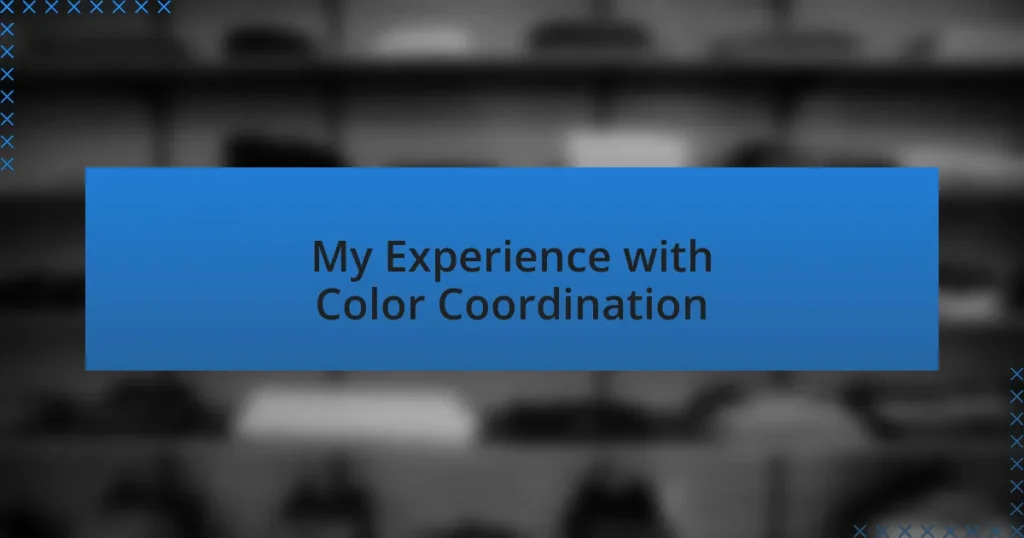Key takeaways:
- Experimenting with bold color combinations, like an emerald green dress with a red belt, can lead to positive feedback and increased confidence.
- Taking risks in fashion, such as wearing a vibrant cobalt blue blazer, can result in unexpected joy and personal style growth.
- Discovering the elegance in minimalist color choices, such as wearing shades of grey, showcases that subtlety can be impactful in style.
Author: Charlotte Hawthorne
Bio: Charlotte Hawthorne is an acclaimed author known for her compelling storytelling and richly drawn characters. With a passion for exploring the complexities of human relationships, her novels often blend elements of romance, intrigue, and self-discovery. A graduate of the University of California, Charlotte has received multiple awards for her work, including the prestigious Silver Quill Award. When she’s not writing, she enjoys hiking in the Sierra Nevada mountains and sipping coffee at local cafes. Charlotte currently resides in San Francisco with her rescue dog, Jasper.
Understanding Color Coordination in Fashion
Color coordination is more than just matching hues; it’s an art that can elevate any outfit. I remember the first time I experimented with contrasting colors. I paired a bright yellow dress with a soft lavender cardigan, which created a playful yet sophisticated vibe. It made me realize how powerful color combinations can be in expressing one’s personality.
When navigating color palettes, I often reflect on the emotional impact of colors. For instance, I discovered that wearing deep blues often makes me feel calm and collected, while vibrant reds exude confidence. Have you ever thought about how a color can influence your mood or the impression you leave on others? This connection between color and emotion can help in curating a wardrobe that resonates with your inner self.
As I ventured deeper into fashion, I found that understanding color theory—like complementary and analogous shades—could enhance my styling choices significantly. For example, combining shades that sit opposite each other on the color wheel can create striking visual contrast. Have you tried pairing similar tones to achieve a softer look? There’s something undeniably fulfilling about experimenting with these concepts and seeing how they transform your style.
Importance of Color Coordination
Color coordination plays a crucial role in expressing individuality and creating impactful impressions. I recall attending a family gathering where I intentionally wore a monochromatic outfit in varying shades of green. The subtle shifts in color not only caught people’s attention, but they also sparked conversations about my style choices. Have you ever noticed how one well-coordinated look can become the topic of discussion?
Beyond aesthetics, color choices can greatly influence how others perceive us. I learned this firsthand during a job interview when I opted for a navy blue suit instead of my usual black. That small shift made me feel more approachable and confident, ultimately contributing to a more positive interaction. Isn’t it interesting how a simple color can change the energy of a situation?
Another aspect of color coordination I’ve embraced is its ability to create harmony in outfits. I remember experimenting with texture and color by pairing a cozy cream sweater with rich burgundy pants. The warm tones complemented each other beautifully, making me feel both stylish and in tune with the upcoming season. How do you feel when all the colors in your outfit effortlessly work together? It’s an empowering experience that can enhance our daily lives.
Basics of Color Theory
Color theory revolves around the relationships between colors and how they can enhance or alter the overall aesthetic of an outfit. I distinctly remember the first time I grasped the concept of complementary colors. I was at a vintage market, and I stumbled upon a vibrant orange dress. When I paired it with a deep blue scarf, the combination felt electrifying and instantly uplifted my mood. Have you ever experienced that rush when two colors just click?
Understanding the color wheel is foundational in color coordination. It’s essentially a visual representation of colors arranged according to their chromatic relationship. I often refer back to my early days of experimenting with fashion, where I learned that colors opposite on the wheel create a striking contrast, like the unforgettable pair of purple and yellow that I once sported at a friend’s wedding. It not only made my outfit pop but also drew compliments from everyone around me. Isn’t it fascinating how color can evoke such strong reactions and create memorable moments?
Another essential aspect of color theory is the use of shades and tints, which can dramatically alter the feeling of an outfit without straying far from a color palette. I recall mixing a soft pastel blue with a darker navy for a brunch outing. This layering created depth and interest in my look without overwhelming the senses. Have you noticed how subtle changes can transform an entire ensemble? It’s like telling a story through color, inviting others to feel the narrative.
Tips for Effective Color Pairing
When considering effective color pairing, it’s crucial to think about the mood you want to convey. I once chose a soft lavender top paired with a rich olive green skirt for a casual evening out. The unexpected combination radiated a sense of calm and creativity, making the entire night feel vibrant yet relaxed. Have you ever felt a shift in your emotions simply based on the colors you wore?
Another tip is to experiment with monochromatic schemes. I remember trying an all-pink outfit for a casual day, varying the shades from blush to fuchsia. It not only created a chic, cohesive look but also instilled a confidence that surprised me. What do you think about the power of shades within the same color family?
Lastly, don’t shy away from accessorizing wisely. Last summer, I paired a mustard yellow dress with a deep purple handbag and neutral sandals. The combination elevated the dress without overwhelming it, showcasing how accessories can add a playful twist to any outfit. Have you seen how a well-chosen accessory can turn a simple outfit into a statement?
My Journey with Color Coordination
Color coordination has been a captivating journey for me, starting with a moment of trial and error. I vividly recall pairing a bright coral blouse with pale grey trousers for a brunch with friends. I stepped out feeling good but soon noticed the color clash making me awkwardly self-conscious. It made me realize how powerful colors are in shaping our perception of ourselves and how they can alter our confidence.
As I delved deeper into color theory, I learned about complementary colors and their striking potential. On one memorable occasion, I wore an emerald green dress with a bold red belt for a summer wedding. The compliments I received were overwhelming and taught me the lesson that sometimes, the most daring choices can shine through when executed thoughtfully. Have you ever experienced that exhilarating moment when you put on an unexpected color combination and instantly feel like a new person?
Over time, I have become more attuned to the subtleties of color. Recently, I decided to try a soft peach scarf against a cream sweater. The gentle contrast was refreshing and made me feel light and radiant. It became clear to me that understanding color coordination is not just about aesthetics; it’s about expressing oneself and embracing the emotions tied to each hue. How do you think colors resonate with your mood and style?
Key Moments in My Experience
A pivotal moment in my color coordination journey occurred during a spontaneous shopping trip. I stumbled upon a vibrant cobalt blue blazer that caught my eye. Hesitating at first, I wondered if I could pull off such a bold statement piece. Buoyed by encouragement from a friend, I decided to give it a chance. When I matched it with a simple white top and black jeans for a casual dinner, I felt a surge of excitement. It was a clear reminder that taking risks can lead to wonderful surprises in my style.
Another memorable instance was when I experimented with layering colors during a weekend getaway. I chose a mustard yellow sweater and layered it over a patterned burgundy shirt. The combination felt refreshing, and I was pleasantly surprised by how the colors complemented each other. I recall receiving compliments from strangers, which added to my confidence and made me realize how every color has its own story. Have you ever mixed colors only to find a combination that surprised you?
Reflecting on my evolution, I recall a time when I opted for a minimalist approach to color. I wore monochromatic shades of grey and charcoal for an art exhibition. At first, I felt like I was playing it safe, but soon I discovered the elegance in simplicity. The subtle variations created depth, making me feel sophisticated yet approachable. Have you ever found beauty in embracing a more understated style? It taught me that sometimes the most impactful choices come from subtlety rather than loud statements.


